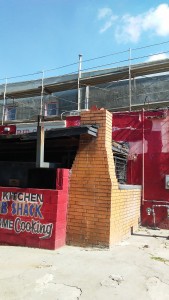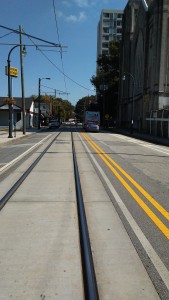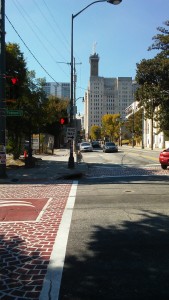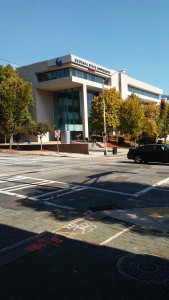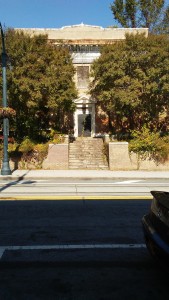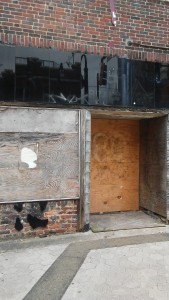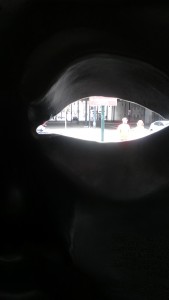Tall, beautiful, majestic, all words that come to mind when you first lay eyes on this architectural marvel. The buildings beautiful exterior eludes from its position along what would seem to be the more “underdeveloped” part of Auburn Avenue. When the building appears on the horizon, it gives off a sense of detachment. The sense only grows stronger as you move towards it, eventually seeing a clear and distinct perimeter surrounding the vicinity. The scenery changes, trees become more abundant, the smell of flowers permeate the air, as it does away with the previous smell of decay.
Category Archives: Images
Building Renovation
Nearly deserted, walking towards Thelma’s Kitchen and its immediate vicinity feels equivalent to walking alongside an alleyway. Located only a couple feet away from the highway, Thelma’s Kitchen is a relic of the past, and its existence seems to almost self-perpetuate its period. Its bright red brick walls stand out amongst its surroundings, making it the center of attention to any passerby. Right next to the shack, a building is undergoing renovations. The metal bars that strut upwards offers a unique view as pedestrians see for themselves the process of change occurring on the street of Sweet Auburn.
Street Disparity
Walking from Georgia State’s T deck to the intersection of its Honors College is an entirely different experience than the proceeding half of Auburn Avenue. Walking towards the Honors College is a breath of city life, the wind hits you, carrying with it a wide variety of smells coming from the numerous restaurants around, coupled with the smell of gasoline, accompanied by honking and sirens, and the sight of other pedestrians, it is the embodiment of city life. Walking the other stretch of the street, you will notice pretty quickly the difference in experience. The sounds change, the increasing sights of homelessness increase, cars, buildings, everything takes an almost 180-degree turn.
Building Disparity
The picture above juxtaposes two buildings, one being Georgia State’s Honors College, while the other, a run-down, abandoned building. The two are found side by side. The Honors College is adorned with modernism, its sharp edges, its cleanliness, the use of glass for natural light; everything about the building exudes an air that befits contemporary society. The building right next to it, however, is the epitome of difference; everything the Honors College is, it is not. Covered in what appears to be kudzu and a variety of other vegetation, the building, both in sight and smell, reek of decay.
Presence of Building Decay
Sweet Auburn, once a thriving area for black commerce and living, is now a husk of its former self. The remnants of days past can be seen throughout the Avenue, as old business buildings, long abandoned, still, stand erect to this day. The buildings presences over the street allude to a more prosperous time; however, its presence in no way diminishes the cultural heritage of the street, if anything, it’s being provides an even more definite feeling of cultural importance. This building, along with others, allows the street to retain its past identity, keeping it from undergoing a complete gentrification.
Through the Eyes of John Dobbs
Looking through the eyes of John Dobbs, the “unofficial mayor” of Sweet Auburn, the entirety of the street can be seen. John Dobbs played a huge role in the perception of the Avenue, as he pushed legislation to be passed that would benefit the street and its community. The presence of Dobbs shaped the area to what it is today; an area of cultural importance to African American history. The statue, dedicated to Dobbs, points his sight towards the street, symbolizing his everlasting presence and the ongoing battle for equality.
Auburn Avenue Signage
The image above is only one of the many signage found throughout the street that depicts old businesses. One of the most important aspect that shaped the cultural fabric of the Avenue was its title as the most successful district for black commerce. The present signage found throughout the Avenue reflects this past glory, and due to their sheer volume shows just how much this title shaped the street.
Congressman John Lewis
The image depicts Congressman John Lewis, a major figure in the fight for black equality. Sweet Auburn itself was the home to many civil rights leaders, such as John Dobbs and Dr. King, this fact demonstrates the deep roots the area has concerning the civil rights movement. The mural of Congressman Lewis is yet another testament to the identity of the street, showing just how important the fight is to its residents. As John Lewis is a major advocate for black equality, his image reflects the cultural influences of the Avenue.
Fountain of Love
The rock seems to have been processed and was not found the way it looks. The rock feels like a granite blend, very cool and smooth to the touch. The dirt found towards the base of the fountain is very old, in an almost dusty kind of way. The soil clearly has not been changed for a long time, and the grass to the side of the fountain feel fake to the touch.
EBC Signage
Black with a bronze outline, the sign states the Ebenezer Baptist Church as a National Historic Landmark. The sign is very gradient to the touch, rough and course. There are signs of corrosion around the border; attributing to the speck of blue found towards the bottom of the sign. The letters are embezzled, they jut outwards from the background, bronze in color, similar to the border. They are smooth to the touch.

